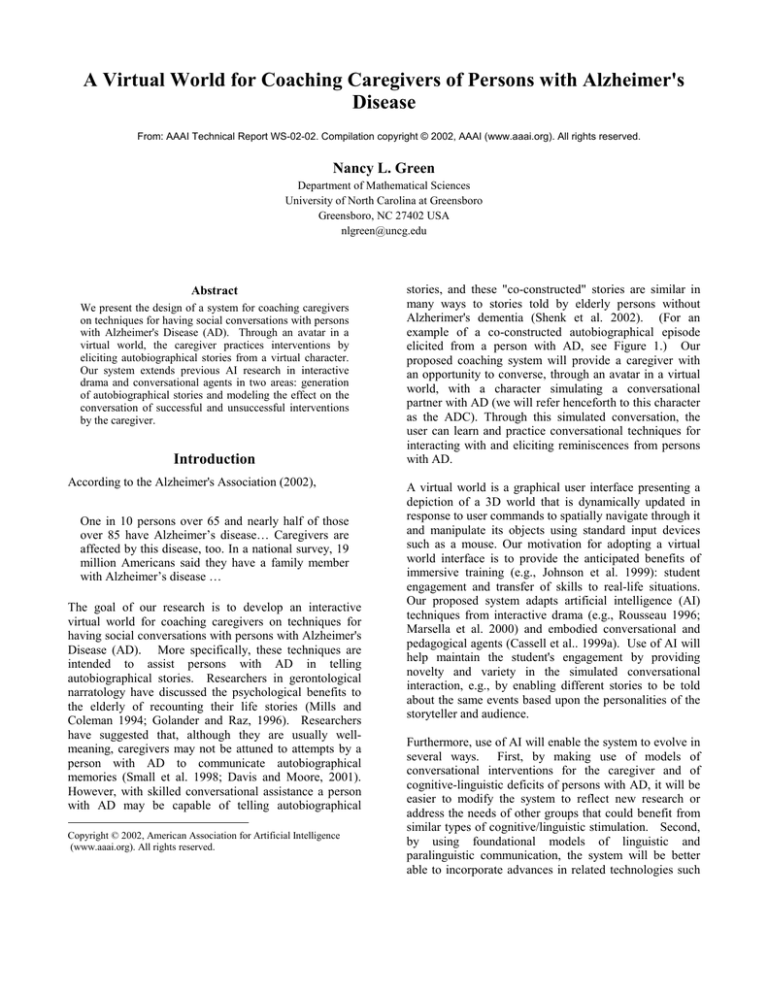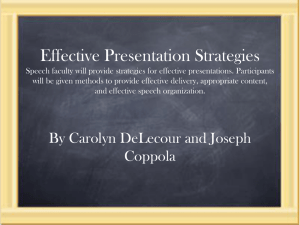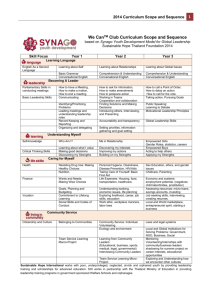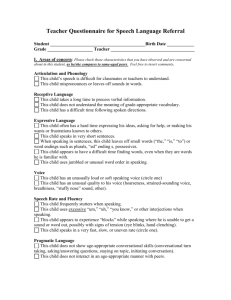
A Virtual World for Coaching Caregivers of Persons with Alzheimer's
Disease
From: AAAI Technical Report WS-02-02. Compilation copyright © 2002, AAAI (www.aaai.org). All rights reserved.
Nancy L. Green
Department of Mathematical Sciences
University of North Carolina at Greensboro
Greensboro, NC 27402 USA
nlgreen@uncg.edu
Abstract
We present the design of a system for coaching caregivers
on techniques for having social conversations with persons
with Alzheimer's Disease (AD). Through an avatar in a
virtual world, the caregiver practices interventions by
eliciting autobiographical stories from a virtual character.
Our system extends previous AI research in interactive
drama and conversational agents in two areas: generation
of autobiographical stories and modeling the effect on the
conversation of successful and unsuccessful interventions
by the caregiver.
Introduction
According to the Alzheimer's Association (2002),
One in 10 persons over 65 and nearly half of those
over 85 have Alzheimer’s disease… Caregivers are
affected by this disease, too. In a national survey, 19
million Americans said they have a family member
with Alzheimer’s disease …
The goal of our research is to develop an interactive
virtual world for coaching caregivers on techniques for
having social conversations with persons with Alzheimer's
Disease (AD). More specifically, these techniques are
intended to assist persons with AD in telling
autobiographical stories. Researchers in gerontological
narratology have discussed the psychological benefits to
the elderly of recounting their life stories (Mills and
Coleman 1994; Golander and Raz, 1996). Researchers
have suggested that, although they are usually wellmeaning, caregivers may not be attuned to attempts by a
person with AD to communicate autobiographical
memories (Small et al. 1998; Davis and Moore, 2001).
However, with skilled conversational assistance a person
with AD may be capable of telling autobiographical
Copyright © 2002, American Association for Artificial Intelligence
(www.aaai.org). All rights reserved.
stories, and these "co-constructed" stories are similar in
many ways to stories told by elderly persons without
Alzherimer's dementia (Shenk et al. 2002). (For an
example of a co-constructed autobiographical episode
elicited from a person with AD, see Figure 1.) Our
proposed coaching system will provide a caregiver with
an opportunity to converse, through an avatar in a virtual
world, with a character simulating a conversational
partner with AD (we will refer henceforth to this character
as the ADC). Through this simulated conversation, the
user can learn and practice conversational techniques for
interacting with and eliciting reminiscences from persons
with AD.
A virtual world is a graphical user interface presenting a
depiction of a 3D world that is dynamically updated in
response to user commands to spatially navigate through it
and manipulate its objects using standard input devices
such as a mouse. Our motivation for adopting a virtual
world interface is to provide the anticipated benefits of
immersive training (e.g., Johnson et al. 1999): student
engagement and transfer of skills to real-life situations.
Our proposed system adapts artificial intelligence (AI)
techniques from interactive drama (e.g., Rousseau 1996;
Marsella et al. 2000) and embodied conversational and
pedagogical agents (Cassell et al.. 1999a). Use of AI will
help maintain the student's engagement by providing
novelty and variety in the simulated conversational
interaction, e.g., by enabling different stories to be told
about the same events based upon the personalities of the
storyteller and audience.
Furthermore, use of AI will enable the system to evolve in
several ways. First, by making use of models of
conversational interventions for the caregiver and of
cognitive-linguistic deficits of persons with AD, it will be
easier to modify the system to reflect new research or
address the needs of other groups that could benefit from
similar types of cognitive/linguistic stimulation. Second,
by using foundational models of linguistic and
paralinguistic communication, the system will be better
able to incorporate advances in related technologies such
as speech recognition and will be easier to modify for
delivery in other languages than English (Calloway et al.
1999). Third, by using foundational models of
conversational narrative, it will be easier to change the
stories that are generated to reflect different life
experiences and cultural assumptions.
In the next section, we summarize system requirements
derived from research on discourse of speakers with
Alzheimer's Disease. In the section following that, we
summarize related work in computer systems. Then we
present the main contribution of this paper, the external
and internal design of our proposed system. We conclude
with a description of the current status of the project and
our future plans.
System Requirements
Speech-language pathologists have identified certain
direct intervention techniques to improve or maintain the
functioning of AD patients "that capitalize on spared
neuropsychological abilities to compensate for impaired
abilities" including cognitive-linguistic stimulation
(Mahendra 2001). The CAPPCI process (Perkins et al.
1997) has been designed to help a normal conversational
partner to analyze the linguistic strategies employed by a
person with AD as a step towards learning interventions
for improving communication with that person. Features
of the person's conversational abilities that are inventoried
include: turn-taking skills (e.g., the ability to initiate
conversation, the failure to respond when selected as next
speaker, failure to hand over conversational floor), topic
management skills (e.g., ability to initiate new topics,
ability to maintain topics), memory ability (e.g., failure to
remember family or events discussed in conversation),
and linguistic abilities (e.g., failure in word retrieval,
overuse of pronouns, production of circumlocutions).
Research on features of discourse of Alzheimer's speakers
has revealed a number of communicative coping strategies
that may be used by a person with AD to maintain
conversational fluency such as use of frozen phrases and
pronominal reference for topic management and use of
exophoric pronominal reference to circumvent the
inability to access lexical resources (Davis, Moore, and
Peacock 2000). By learning to recognize such features
and accommodating for them, the conversational partner
can provide the person with AD with an opportunity for
social interaction and validation of himself or herself.
To summarize basic system requirements motivated by
this body of research, the system should provide training
in three areas. First, the normal conversational partner
needs to provide cues that signal interest and engagement
in the conversation, e.g., by means of head nodding, gaze,
or verbal feedback. Second, the partner needs to
recognize the communicative coping strategies of the
person with AD and react appropriately. Third, the
partner can provide linguistic cues to help the person with
AD recall information in episodic memory and to help
prime lexical access. Thus, the system will model the
conversational behavior of a person with AD through the
ADC, enable the learner to influence the behavior of his
or her avatar in a simulated conversation with the ADC in
the virtual world, and thereby observe the success or
failure of his or her actions on the simulated conversation.
Related Work
Computer-based role-playing training systems are starting
to
become
available
commercially
(e.g.,
www.extempo.com). The systems derive from research
on synthetic characters that improvise their behavior,
within the constraints of a stereotypical scenario such as
dining at a restaurant, using AI models of personality and
emotion (Rousseau 1996). Those and other researchers
have stressed the importance of modeling human
personality and emotion in order to make synthetic
characters believable and engaging (Elliott and Brzezinski
1998; Loyall 1997).
Carmen's Bright Ideas is a prototype instructional health
system designed to allow mothers of pediatric cancer
patients to improve problem-solving skills by learning a
set of techniques, the Bright IDEAS method, through an
interactive drama (Marsella et al. 2000). The animated
multimedia drama portrays a session between a counselor
and Carmen, the mother of a pediatric cancer patient. At
points in the story, the user is allowed to choose from a set
of thoughts and feelings that Carmen might be
experiencing at the moment, which causes Carmen to act
accordingly. The developers focused on the problem of
controlling the plot and meeting pedagogical objectives
while allowing the user to influence the behavior of the
Carmen character.
GrandChair, a system using the ECA architecture (Cassell
et al. 1999b), is designed to record stories told by elderly
persons (Smith 2000). To encourage an elderly user of
the system to tell stories, the system presents an animated
child character that appears to listen to the user. The
system uses cues such as intonation, body motion, and
keyword spotting as the basis for generating the synthetic
listener's responses.
While our system will build upon much of the above
work, it must address additional problems. In contrast to
GrandChair, for example, the intended user of our system
is a caregiver who wishes to learn techniques to elicit
stories. Thus, our system must be able to create
autobiographical stories that will be told by the ADC in
the course of a simulated conversation with the caregiver's
avatar. Furthermore, the ADC's generated discourse must
model the discourse of a person with AD. Finally, the
ADC's conversational behavior must model the effects of
successful and unsuccessful interventions by a caregiver
on conversation with a person with AD.
System Design
This section presents the external and internal design of
our proposed system, shown in Figure 2. (Components in
the figure appear below in bold font.)
User Interaction in Virtual World
The intended user of the system is a caregiver (Live
Student Caregiver) who wants to learn or practice
interventions for encouraging a person with AD to tell
autobiographical stories. The 3D graphical user interface
presents a Virtual World set in a sitting room that
includes (1) an animated character representing a
caregiver (Caregiver Avatar), (2) an animated character
representing a person with AD (AD Character), i.e., the
ADC, (3) and Secondary Characters that appear from
time to time such as unexpected visitors and health care
workers. The simulated dialogue is presented using
sound. From time to time, the user is offered a choice of
several interventions that the avatar could perform at the
present moment, depicted in menu form over Caregiver
Avatar's head. The user indicates his selection by a
mouse click. In addition, the user can control the avatar's
backchannel dialogue actions by mouse movement while
the ADC (AD Character) is talking.
Internal Design
The Caregiver-coach Agent and Conversational
Storyteller Agent are the "brains" of the Caregiver
Avatar and AD Character, respectively. They each send
instructions to the User Interface Director & Event
Detector for controlling their respective character's
linguistic and paralinguistic (facial expression, etc.)
actions. The User Interface Director & Event Detector
is responsible for translating these actions into animation
and audio instructions in the virtual world. (Audio
instructions include playing segments of recorded speech.)
In addition, this Director coordinates system-generated
events in the virtual world, controls the lighting and the
"camera's eye", and generates the actions of the secondary
characters. In addition, whenever the user performs an
input action this component records the event in the
Dialogue Model.
Since interpretation of linguistic and paralinguistic actions
is a difficult problem that need not be addressed for our
purposes, our design avoids the requirement for the
Caregiver-coach Agent and Conversational Storyteller
Agent to interpret what the other's realized dialogue
actions meant.
Instead, the function and form of
expression of each agent's actions is encoded by the
generating agent in the shared Dialogue Model. (This
shared data structure should not be confused with a
representation of the characters' shared beliefs, which only
comprises one element of the Dialogue Model, the
Common Ground.) In other words, while the dialogue is
simulated in the interface for the user's benefit, no
interpretation need be performed in our system because,
unlike in the real world, both agents have access to
information stored in each other's "brain".
However, in order to support the generation of the agents'
dialogue, it is necessary to maintain a rich Dialogue
Model, whose components are motivated by previous
work in discourse analysis, conversational narrative (e.g.,
Polanyi 1989), and computational models of emotion
(e.g., Rousseau 1996; Velasquez 1997). In particular, it
includes a (1) Discourse Model: the Textual, Ideational,
and Interactional levels of the dialogue (Georgakopoulou
and Goutsos 1997); (2) an Emotion-Personality Model:
the affective state of the Storyteller Agent (3) a
Narrative Model: structural and episodic information
from the story; and (4) the Common Ground (Clark
1996): information conveyed in previous conversations,
shared knowledge of events and objects in the current
conversational setting, semantic associations between
lexical items, and shared knowledge of famous events
The Caregiver-coach Agent is composed of three
modules that operate in sequence. Initially, the Action
Proposal Module selects the set of possible actions from
the caregiver's Action Repertory that are relevant with
respect to the current Dialogue Model. Next, the Action
Selection Module decides whether to let the user select
the next action from the set of possible actions; if the user
is not granted the choice, then this module chooses the
most appropriate action; in either case the choice is sent to
the Dialogue Realization Module. Finally, the Dialogue
Realization Module decides how to express the selected
action in language and/or through paralinguistic actions
such as facial expression, gesture, intonation, etc. The
advisability of architecturally distinguishing dialogue
function, corresponding to the level of representation in
the Action Repertory, from dialogue behavior,
corresponding to the level in the Dialogue Realization
Module, has been argued for by Cassell et al. (1999b).
The Conversational Storyteller Agent also consists of
three modules operating in sequence. Initially, the Action
Proposal-Selection Module selects the agent's next
action from the set of actions in this agent's Action
Repertory that apply given the current Dialogue Model.
If the selected action is a storytelling action type, story
content is supplied next by the agent's Storytelling
Action Refinement Module. This module makes use of
information in the agent's Life Episodes Model, a
representation of the agent's autobiographical memory.
Also, the state of the Dialogue Model may influence the
selection of an episode or details from an episode in order
to achieve narrative goals. Finally, both non-storytelling
actions and refined storytelling actions are expressed by
the agent's Dialogue Realization Module.
The design of the Conversational Storyteller Agent, as
described so far, does not account for how the system can
provide a believable simulation of conversational
behavior of a person with AD. First, in the Action
Proposal-Selection Module, the agent's inclination to
begin or to continue telling a story depends on the state of
the Discourse Model and the agent's Emotion-Personality
Model. These models are influenced by the actions of the
caregiver in the preceding dialogue and by the perceived
success or failure of the storyteller's own attempts to
communicate in the preceding dialogue. Second, the
Storytelling Action Refinement Module is influenced by
what storytelling routines and what parts of the Life
Episodes Model are accessible currently. Accessiblity is
influenced by the presence of triggers in the Common
Ground of the Dialogue Model. These triggers arise
from events and objects in the current conversational
setting or from semantic priming from the preceding
discourse. Third, the Dialogue Realization Module will
be restricted in lexical choice and production of referring
expressions. Lexical choice will be limited by what parts
of the agent's lexicon are accessible currently, where
accessibility is influenced by the triggers described earlier.
Referring expressions will be limited to pronominal
forms. In addition, certain types of pragmatic functions
will be realized using strategies characteristic of
Alzheimer's discourse, e.g., using frozen phrases to signal
topic closure.
Conclusion and Future Work
We have presented the external and internal design of a
system for coaching caregivers on techniques for having
social, autobiographical conversations with persons with
Alzheimer's Disease. Currently, we are developing a
rapid prototype using a 3D Virtual Worlds authoring tool,
Alice (www.alice.org), for the user interface. The purpose
of implementing the prototype is to get user feedback on
the design of the user interface such as input actions to
control the avatar's head nodding action. Later, after the
Conversational Storyteller agent has been implemented we
plan to ask researchers who study discourse of persons
with AD to evaluate the believability of its conversational
behaviors.
After the fully implemented system is deployed, we plan
to perform several types of evaluation with different
objectives. The first type of evaluation will be to analyze
logs of student usage of the system to determine to what
extent students' selection of correct interventions improves
over time. One goal of this type of evaluation is to
discover whether particular interventions are not being
learned so that the system's approach to teaching them can
be redesigned. In addition, questionnaires will be used to
evaluate subjective factors such as user satisfaction.
However, these methods cannot tell us whether the
training will transfer to real-life situations, and whether
the interventions being taught truly are effective in
improving communication between caregivers and
persons with AD. Thus, field trials will be conducted by
geriatrics experts to compare the communicative
effectiveness of caregivers who have been trained by our
system to those who have had no training.
Acknowledgments
We wish to thank Dr. Boyd Davis of the University of
North Carolina at Charlotte for suggesting that we embark
upon this project, for introducing us to research on the
discourse of persons with AD, and for continuing to
encourage us to pursue this work.
References
Alzheimer’s Disease and Related Disorders Association,
Inc. 2002. http://www.alz.org/people/faq.htm
Calloway, C., Daniel, B., and Lester, J.
1999.
Multilingual Natural Language Generation for 3D
Learning Environments. In Proceedings of the 1999
Argentine Symposium on AI, 177-190.
Cassell, J. et al. eds. 1999a. Embodied Conversational
Agents. Cambridge, MA: MIT Press.
Cassell, J., Bickmore, T., Campbell, L., Vilhjalmsson, H.,
and Yan, H. 1999b. Conversation as a System
Framework: Designing Embodied Conversational Agents.
In Cassell, J. et al. eds., Embodied Conversational Agents.
Cambridge, MA: MIT Press.
Clark, H. 1996. Using Language. Cambridge University
Press.
Davis, B., Moore, L., and Peacock, J. 2000. Frozen
phrases as requests for topic management: effect and
affect in recepient design by a speaker of Alzheimer's
discourse. Presented at NWAV2000, Michigan State
University.
Davis, B. and Moore, L. 2001. Retaining a stake.
Presented at NWAV2001, North Carolina State University.
Elliott, C. and Brzezinski, J. 1998. Autonomous Agents as
Synthetic Characters. AI Magazine Summer: 13-30.
Georgakopoulou, A. and Goutsos, D. 1997. Discourse
Analysis: an Introduction.
Edinburgh: Edinburgh
University. Press.
Golander, H. and Raz, A.E. 1996. The mask of dementia:
images of 'demented residents' in a nursing ward. Ageing
and Society 16: 269-85.
Johnson, W.L., Rickel, J.W., and Lester, J.C. 2000.
Animated Pedagogical Agents: Face-to-Face Interaction in
Interactive Learning Environments. International Journal
of Artificial Intelligence in Education.
Loyall, A.B. 1997. Believable Agents: Building
Interactive Personalities. Ph. D. diss., Dept. of Computer
Science, Carnegie Mellon University.
Mahendra, N. 2001. Direct Interventions for Improving
the Performance of Individuals with Alzheimer's Disease.
Seminars in Speech and Language 22(4).
Marsella S., Johnson, W.L., LaBore, K. 2000. Interactive
Pedagogical Drama. In Proceedings of the 4th
International Conference on Autonomous Agents. Agents
2000.
Mills, M.A. and Coleman, P.G. 1994. Nostalgic memories
in dementia: a case study. International Journal of Aging
and Human Development 38(3): 203-19.
Perkins, L., Whitworth, A., and Lesser, R. 1997.
Conversational Analysis Profile for People with Cognitive
Impairment. London: Whurr Publishers.
Polyani, L. 1989. Telling the American Story: A
Structural and Cultural Analysis of Conversational
Storytelling. Cambridge, MA: MIT Press.
Rousseau, D. 1996. Personality in Computer Characters.
In Proceedings of 1996 AAAI Workshop on AI and
Entertainment and AI Life, 38-43.
Shenk, D., Davis, B., Peacock, J.R., and Moore, L. 2002.
Narratives and Self-Identity in Later Life: Case Studies of
Two Rural Older Women. Aging and Society,
forthcoming.
Small et al. 1998. The discourse of self in dementia.
Aging and Society 18: 291-316.
Smith, J. 2000. Grandchair: Conversational Collection of
Grandparents' Stories. M.S. Thesis, MIT.
Velásquez, J. 1997. Modeling Emotions and Other
Motivations in Synthetic Agents. In Proceedings of the
Fourteenth
National
Conference
on
Artificial
Intelligence. Providence, RI: MIT/AAAI Press
Glory: I just lived in a regular farm home. Farmed cotton, corn, eh-everything you … grow on a
farm.
BD: That's right.
Glory: I had a big ol' cotton bag tied around me, pickin' a hundred pounds of cotton … UhhmmHmm.
BD: A hundred pounds? An' you so tiny!
Glory: Huh?
LM: You're a tiny person to be carrying that much cotton.
Glory: I decided one day I'd pick a hundred pounds. Guess how much!
LM: How much?
Glory: A hundred and three.
LM: Oooohh.
BD: Wow.
Glory: I went over.
BD: That's fantastic.
Glory: A hundred and three -- you've got to grab it to … get a hundred and three pounds of
cotton in one day.
Figure 1: Transcript of conversation between Glory, an elderly nursing home resident with Alzheimer's disease,
and two visitors (LM and BD) in which Glory is encouraged to talk about her life as a young woman (Shenk et
al., 2002).
Live student
caregiver
User input
Interventions
Simulated Dialogue
Animation &
audio
instructions
Caregiver avatar
Virtual Camera &
Lighting
AD character
Virtual World
Secondary
characters
User Interface Director & Event
Detector
Caregiver-coach Agent
System
Conversational
Storyteller Agent
Discourse Model
Emotion-Personality Model
Narrative Model
Common Ground
Dialogue Model
Figure 2: External and Internal System Design.
Life
Episodes
Model







